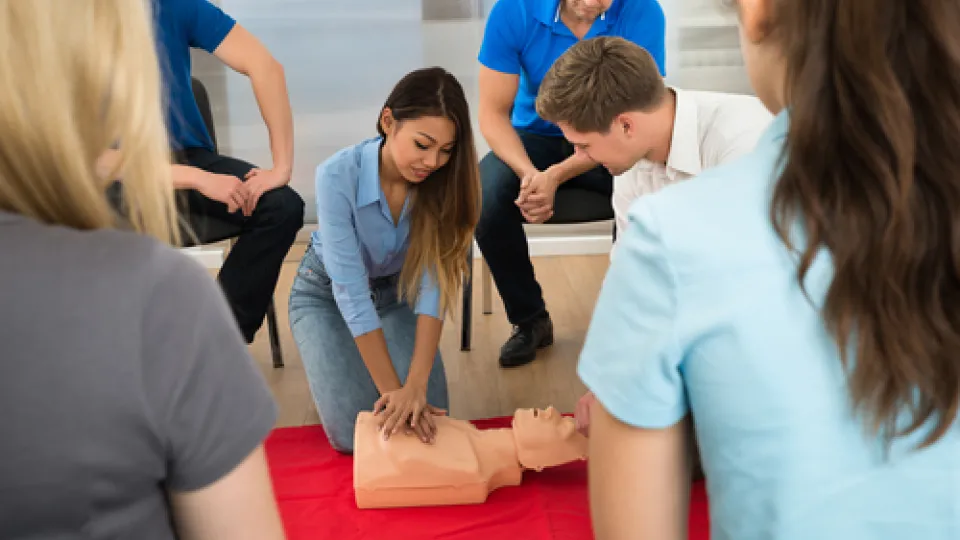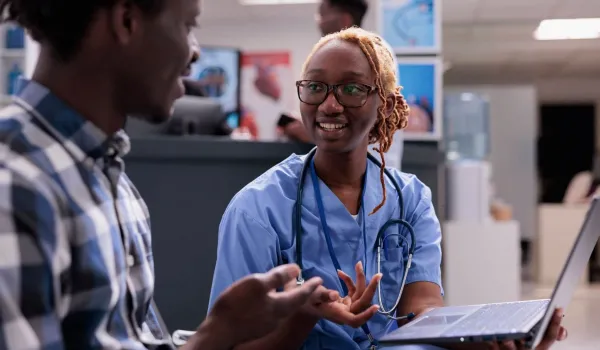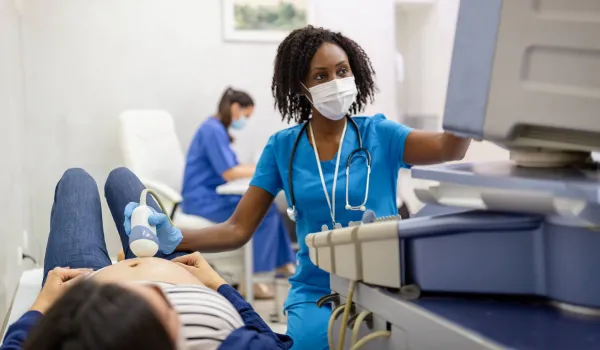
The value of knowing how to perform Cardiopulmonary Resuscitation (CPR) goes beyond simply improving health care awareness. Being CPR trained can help save a life.
That's why most of Concorde's 20-plus health care programs have a CPR education component within the curriculum. Whether you're becoming a Medical Assistant, becoming a Nurse, becoming a Surgical Technologist, even becoming a Dental Assistant or a Dental Hygienist, CPR is the basic foundation of health care. It can make all the difference between life and death.
Being there when needed
"Once the heart stops pumping and there is no respiration, CPR can be performed," said Erica Hamer, Tutor and CPR Instruction Coordinator at Concorde's campus in Memphis, Tennessee. "CPR is effective as soon as possible. Everyone knows to call 911 for any emergency, but knowing what to do in an emergency medical situation can mean the difference between life and death."
"Waiting on the paramedics to get there is a waste of time. Step right up and do the skills you have been taught. Someone's life is depending on you."
CPR health care awareness
According to Hamer, CPR consists of two main procedures - compressions and giving breaths. Compressions are done by pressing down on the chest to attempt to pump blood through the valves of the heart and throughout other parts of the body. Respirations or giving breaths is performed to restore breathing in a person who has stopped breathing.
"Cardiac arrest is the leading cause of death in the United States and Canada," Hamer said. "Bystanders in public places play an important role in improving the chances of survival."
Another important piece to CPR, Hamer said, is health care awareness surrounding the use of the Automated External Defibrillator (AED). Statistics show that the use of an AED increases the chances of survival up to 75 percent.
"Each AED machine is easy to use for bystanders," Hamer said.
Difference between Infant, Child, and Adult CPR
Cardiopulmonary resuscitation (CPR) involves assisting someone of any age when his or her heartbeat and breathing have stopped.
There are two main steps to CPR:
- Providing chest compression's to keep the blood moving when the heart isn't pumping
- Providing rescue breathing to give the lungs oxygen when someone can't breathe on their own. You should also check for a blocked airway.
The process of CPR is similar for assisting adults, young children, or infants, but there are key differences. CPR training defines an infant as a child who is less than a year old, a child as someone older than a year but who hasn't reached puberty, and an adult as anyone who is at the age of puberty or older.
Here's an overview of the differences between infant, child and adult CPR.
CPR for Infants
Infants are the most fragile and extra care should be given when providing CPR. As with young children, infants' bones are more flexible than adults, but also more delicate. Here are the steps to take with an infant for CPR:
- Is the baby conscious? Before you begin CPR on a child or adult, you will need to determine if the baby is conscious. For a baby shaking is not advised so instead gently stroke the baby, or tap the soles of the feet and watch for movement or another response.
- Perform CPR before calling 911. As with small children, infants have a higher survival rate than adults when receiving immediate CPR. If you are alone, provide CPR first-and then call 911 after five CPR cycles or two minutes. If there is anyone else present, have that person call 911 while you provide CPR.
- Check for a pulse. The place where you check for a pulse in infants is different than for children and adults. Instead of using the carotid artery, check for a pulse on the inside of the upper arm, where the brachial artery is found.
- Provide rescue breaths. Infants have very fragile airways that become blocked easily. Tilting the head back too far can make the problem worse. The correct position for infants is called the "sniffer's position"-which entails tilting the head back just enough to make the baby appear to be sniffing the air.
- When providing rescue breaths, be very gentle. Use your cheeks rather than the full strength of your lungs to blow air into the baby's mouth. Because babies' faces are so small, you can cover their entire mouth and nose as opposed to just their mouth when providing rescue breaths.
- Provide compressions. Because they are so small, babies only require two fingers in the center of the chest during chest compressions. Compressions for infants should only be an inch to an inch and a half deep. Frequency should be 30 compressions to two rescue breaths.
CPR for Children
Most of the techniques used for children aged one to eight years old are the same as those recommended for adults. Here's an overview of the places where there are differences. Here is what makes giving CPR to a child different than both an adult and an infant:
- Start CPR before calling 911. Like an infant start CPR immediately on a child if you are the only person present and you have to make a choice between beginning CPR and calling emergency response. This is because children are generally more resilient than adults, and their chances of survival if they receive immediate CPR are much higher-approximately 70%. If alone, you should call 911 after providing CPR to a child after five compression and breath cycles, which should last about two minutes. Of course, if there are other people around, someone else should call 911 immediately as you perform CPR.
- Provide rescue breaths. Children's airways are more fragile than adults'. As a result, you must be more careful when providing rescue breaths to a child not to tilt the head back too far. This can actually block the airway further, especially for smaller children. So be careful in tilting the head back, and breathe more gently with a child than you would with an adult.
- Provide compressions. Depending on the size of the child, you can use one or two hands to provide compressions. Because children have smaller chests than adults, the depth of compressions should be only one and a half inches. The compression and breath rate should be the same for children as for adults-30 compressions to two breaths.
- AED treatment. If you have access to an AED, you should use it after five cycles or about two minutes of CPR. Use the pediatric pads if they are available.
CPR for Adults
Adults can suffer from choking, blocked airways, drowning incidents, and other problems, but most adults need CPR when they experience cardiac arrest. Here's an overview of what steps make giving CPR to an adult different from children and infants:
- Call 911 Immediately. When performing CPR on an adult, you should call 911 immediately before beginning CPR if you are the only person present unless you believe the person is unconscious because of a blocked airway; in which case you should call 911 after providing CPR for a minute. If there are others nearby, someone else should call 911 while you begin
- Check for a pulse. It's usually easiest to find the pulse on an adult by checking the carotid artery on the neck, just below the jaw, with two fingers.
- Provide rescue breaths. Hands-only CPR is currently recommended by the American Heart Association, particularly for people who are not experienced in delivering CPR. But if you do provide rescue breaths to an adult, you'll tilt the victim's head back slightly and clear the airway with a finger before breathing.
- Provide compression. For an adult, you'll provide compressions with two hands in the center of the chest, putting pressure through the heels of your hands. The depth of compression for adults should be approximately 2 inches as compared to 1-1.5 inches for a child.
While the steps for performing CPR are not vastly different between infants, children and adults there are some important steps that could be the difference between saving someone's life. Having knowledge of the proper steps will make you feel comfortable in any situation.
Beyond CPR
"In addition to CPR, basic first aid is important," she said. "You should know how to apply pressure to a wound and how to treat it. Choking is the fourth-leading cause of death in infants. That's because children are likely to put small objects in their mouths, for example, nuts and grapes."
Knowing how to perform CPR is a comforting feeling at the least and can be an extremely gratifying personal experience should you ever be called upon to use it. That's why it should always be a key component of any health care training.
"The feeling you have after you have saved a life is unbelievable, and the look on family members' faces when they noticed you have actually saved their loved one is unconditional," Hamer said. "I recommend everyone learn CPR."
"Finding classes isn't hard. Check your local school, fire stations, and hospitals to see if they offer classes. You'll be happy you did."
Take The Next Step Towards a Brighter Future
We have a Concorde representative ready to talk about what matters most to you. Get answers about start dates, curriculum, financial aid, scholarships and more!




